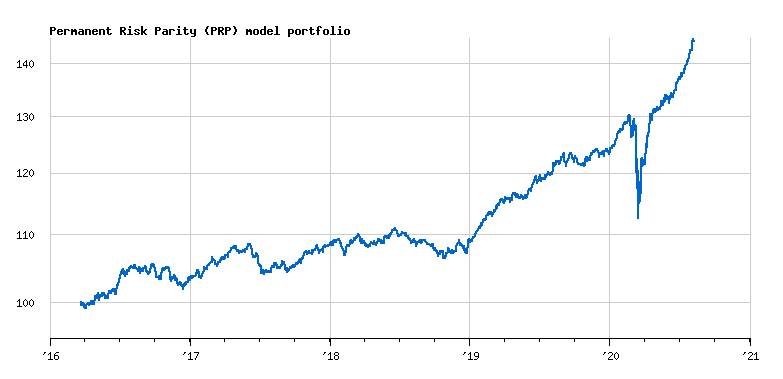CapitalTime
Articles on investing and capital management, with a quantitative focus.
Withdrew from PRP
2020-08-10
I have one investment account which needs to be liquidated before moving elsewhere. This is a “forced selling” scenario, but I have no choice. The amount is roughly 8% of my investments and I will have to be out of the market for a few months.
There are two problems with exiting the market temporarily:
- The market can move against you in the mean time (it can rise)
- You may hesitate to get back in
I must admit that I tried to “time” the withdrawal. I have been watching the PRP allocation soar recently, mainly on the strength of stocks and gold. It’s a pretty dramatic move upward:
Yesterday, I decided to pull the trigger and sell, to withdraw the 8% in question. This meant selling the PRP at an index level of 144.4 based on my model portfolio. I think this is a reasonable point to sell at.
Preserving the asset allocation
I specifically sold the S&P 500 and gold. Note that this withdrawal preserves the allocation weights in my plan. After the withdrawal, my weightings are:
- 29% stocks
- 51% bonds
- 20% gold
These are nearly exactly the #prp weights, so I’m still invested according to the plan. Just to be clear: I still own the S&P 500 and gold. I just have less than before.
Commitment to buy back
There’s no way to know which way markets could go between now and when I’m able to reinvest these funds. I might have to buy higher than 144.4 (the PRP index level when I sold).
To avoid the indecisiveness that comes with re-entering the market, I’m making the following rule for myself:
Once I have access to these funds and can invest them again, I will give myself one month to make the purchases. That means that I can’t sit on the cash forever. By the end of that month, I must buy everything, no matter what the price is.
— Jem Berkes
